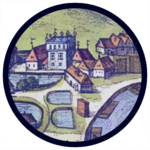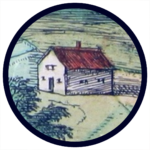Types of Polish stately homes
In Poland, several terms are used to describe the various types of historic buildings – large and small – that might today be considered to constitute a stately home. Among them are words like dwór, pałac, zamek, folwark, and kamienica. Below we consider the distinctions between these terms. Although they have rough parallels in the buildings of other European countries, Poland’s unique architectural and societal history means that it is often difficult to translate such words precisely into English-language terms like “mansion,” “manor house,” “townhouse,” or “castle.”
 The Dwór (“Manor House”) - The dwór or “manor house” is a charming and characteristic feature of the Polish landscape whose basic design dates back to the Polish Renaissance and which was the traditional dwelling-place of Poland’s szlachta (or “nobility”). Of the 12,000 dwory that Poland possessed during the interwar period, less than 3,000 still exist today.
The Dwór (“Manor House”) - The dwór or “manor house” is a charming and characteristic feature of the Polish landscape whose basic design dates back to the Polish Renaissance and which was the traditional dwelling-place of Poland’s szlachta (or “nobility”). Of the 12,000 dwory that Poland possessed during the interwar period, less than 3,000 still exist today. The Pałac (“Palace”) - The Polish pałac (or “palace”) is a grand residential structure – typically fashioned of stone or brick – that is taller and more formidable than a dwór and possesses more elaborate ornamentation than a castle. Many Polish palaces display considerable Italian Renaissance or Baroque influences, thanks to the historical flow of architects between the countries.
The Pałac (“Palace”) - The Polish pałac (or “palace”) is a grand residential structure – typically fashioned of stone or brick – that is taller and more formidable than a dwór and possesses more elaborate ornamentation than a castle. Many Polish palaces display considerable Italian Renaissance or Baroque influences, thanks to the historical flow of architects between the countries. The Zamek (“Castle”) - The fortified stone zamek or “castle” was a successor to the gród, a fortified wooden settlement that had been constructed in the territory that is now Poland from ancient times up through the early Middle Ages.
The Zamek (“Castle”) - The fortified stone zamek or “castle” was a successor to the gród, a fortified wooden settlement that had been constructed in the territory that is now Poland from ancient times up through the early Middle Ages. The Folwark (“Grange”) - The folwark (“grange” or “farmhouse”) had appeared in Poland by the 14th century as a kind of building associated with grain production on monasteries’ estates. Some folwarki resemble especially plain manor houses; however, a folwark was more purely functional in nature.
The Folwark (“Grange”) - The folwark (“grange” or “farmhouse”) had appeared in Poland by the 14th century as a kind of building associated with grain production on monasteries’ estates. Some folwarki resemble especially plain manor houses; however, a folwark was more purely functional in nature. The Kamienica (“Townhouse”) - The kamienica is an urban residence built of brick or stone and possessing at least two stories. The kamienice that line the market squares of Poland’s older cities may date back to Renaissance or Baroque times.
The Kamienica (“Townhouse”) - The kamienica is an urban residence built of brick or stone and possessing at least two stories. The kamienice that line the market squares of Poland’s older cities may date back to Renaissance or Baroque times.